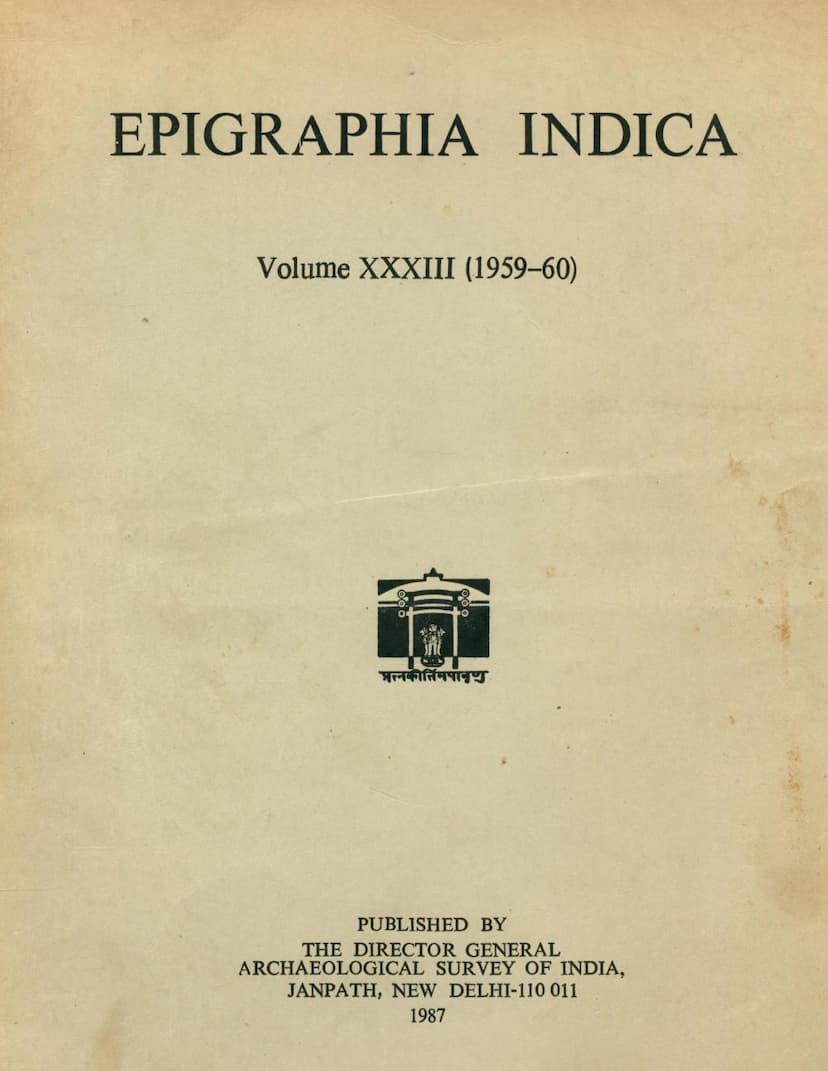Epigraphia Indica Vol 33
Added to library: September 1, 2025

Summary
The provided text is a collection of inscriptions from Volume XXXIII of Epigraphia Indica (1959-1960), edited by D. C. Sircar and published by the Archaeological Survey of India. The catalog link provided (https://jainqq.org/explore/032587/1) points to a page that likely contains digitized versions or references to this volume, although direct access to the content is limited to Jain Education International for private and personal use.
Based on the table of contents and the beginning of the first article, this volume is a collection of 61 epigraphic articles published between 1959 and 1960, covering a wide range of historical periods and geographical regions across India. The inscriptions are primarily on stone and copper plates and are primarily in Sanskrit, Prakrit, Kannada, Telugu, and Oriya languages.
Here's a summary of the key aspects of this volume based on the provided pages:
1. Publisher and Editor:
- Publisher: Archaeological Survey of India, Janpath, New Delhi.
- Editor: Dr. D. C. Sircar, a renowned epigraphist and historian.
2. Content:
- Volume Number: XXXIII
- Years Covered: 1959-1960
- Number of Articles: 61 articles (listed from No. 1 to No. 61).
- Types of Inscriptions: The volume includes a diverse range of epigraphic material, such as:
- Copper-plate grants: Numerous grants detailing land donations, administrative orders, and royal genealogies. Examples include grants by Raghudeva, Bhoja Prithivimallavarman, Vajrahasta III, Kapilesvara, and Srichandra.
- Stone inscriptions: Inscriptions found on pillars, temple walls, and other stone artifacts. Examples include inscriptions from Tippasamudram, Dongalasani, Baraudi, Narwar, Kapilas, Jalore, Veraval, Gaya, Bhairavakonda, Unchahra, Bhaturiya, and Nagarjunakonda.
- Other epigraphic material: This volume also features articles on copper coins (No. 17) and possibly other types of inscriptions.
3. Key Themes and Historical Periods Covered: The inscriptions span various historical periods and dynasties, offering insights into:
- Early Dynasties: Mention of Gupta Age inscriptions (No. 56).
- Medieval Dynasties: The volume extensively covers inscriptions from rulers and dynasties such as:
- Suryavamsi Gajapatis of Orissa (No. 1, 5, 52)
- Yajvapalas/Jajapellas (No. 4, 10)
- Chahamana Chachigadeva (No. 6)
- Chalukyas (No. 2, 58)
- Hoysalas (No. 20)
- Kakatiyas (No. 20)
- Vijayanagara rulers (No. 20, 39, 43)
- Paramaras (No. 38, 42)
- Chaulukyas (No. 21)
- Somavamsis (No. 50, 51)
- Eastern Gangas (No. 19, 35)
- Bhojas (No. 9)
- Kalachuris (No. 36)
- Rashtrakutas (No. 48)
- Chandras (No. 25)
- Andhra rulers (No. 37)
- The inscription from Nagarjunakonda (No. 27) relates to the Ikshvāku king Ehavalasri.
- Religious and Social History: The inscriptions shed light on the patronage of Buddhism (No. 27, 49), Jainism (No. 6), and Hinduism (various inscriptions mentioning Siva, Vishnu, Durga, Ganesa, etc.), as well as religious practices like the performance of sraddhas and the establishment of perpetual lamps.
- Administrative and Economic History: Details about land grants, villages, taxes, official designations, and economic activities are present.
- Palaeography and Language: Articles often discuss the script used, its evolution, and linguistic features, noting influences from local dialects on Sanskrit.
3. Editorial Approach:
- Scholarly Rigor: The volume is characterized by meticulous editing, with detailed discussions on palaeography, orthography, language, historical context, and identification of geographical names and rulers. Dr. D. C. Sircar, as the editor and a frequent contributor, brings his extensive expertise to bear on these studies.
- Collaboration: Several articles are co-authored, indicating a collaborative effort in epigraphic research.
4. Significance:
- Primary Source Material: Epigraphia Indica volumes are crucial primary source materials for understanding the political, social, religious, and economic history of ancient and medieval India.
- Dissemination of Research: This volume makes accessible important epigraphic findings for the academic community, facilitating further historical research.
- Correction of Previous Works: Dr. Sircar and other contributors often engage with and correct previous readings or interpretations of inscriptions, highlighting the dynamic nature of epigraphic scholarship.
In essence, Epigraphia Indica, Vol. XXXIII is a scholarly compilation of significant epigraphic records, providing invaluable raw data and expert analysis for the reconstruction of India's past, particularly during the medieval period. While the specific details of each of the 61 inscriptions are extensive, the volume as a whole serves as a vital repository of historical information.